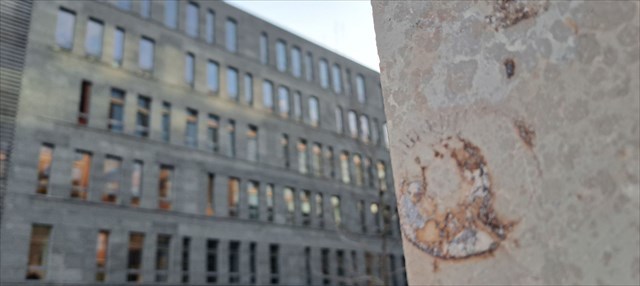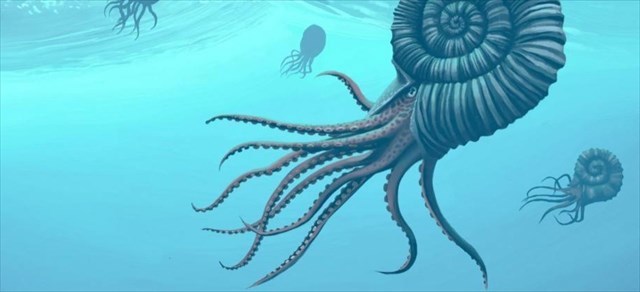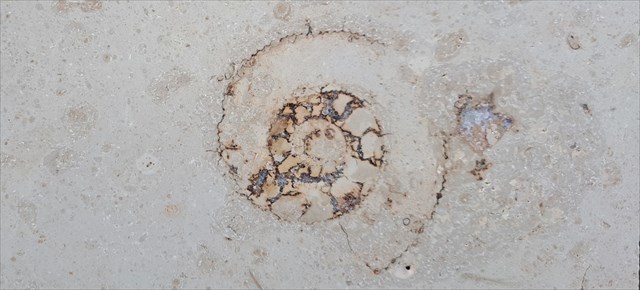|

 Jeden z obkladů na Rohanském nábřeží v Praze ukrývá zkamenělé, miliony let staré živočichy. Vítejte u mé další EarthCache. Jeden z obkladů na Rohanském nábřeží v Praze ukrývá zkamenělé, miliony let staré živočichy. Vítejte u mé další EarthCache.
 One of the walls on Rohanské nábřeží in Prague hides petrified, millions of years old fossils. Welcome to my next EarthCache. One of the walls on Rohanské nábřeží in Prague hides petrified, millions of years old fossils. Welcome to my next EarthCache.

Jurští Amonité / Jurassic Ammonites
 Jurští amonité byla rozmanitá skupina mořských měkkýšů, která žila v období jury přibližně před 201 až 145 miliony let. Amoniti patřili do třídy hlavonožců (Cephalopoda), do které spadají i současné sépie, chobotnice a nautily. Tyto pradávní tvorové byli velmi rozšíření a hojní, obývající různá místa v oceánech jury. Jurští amonité byla rozmanitá skupina mořských měkkýšů, která žila v období jury přibližně před 201 až 145 miliony let. Amoniti patřili do třídy hlavonožců (Cephalopoda), do které spadají i současné sépie, chobotnice a nautily. Tyto pradávní tvorové byli velmi rozšíření a hojní, obývající různá místa v oceánech jury.
Amoniti se vyznačovali svými stočenými, komůrkovanými ulity, které připomínaly tvar beraních rohů nebo pevně stočeného hada. Název "amonit" pochází ze spirálovitého tvaru jejich ulit, které připomínají rohy starověkého egyptského boha s beraní hlavou, Amona. Tyto ulity poskytovaly ochranu a umožňovaly amonitům regulovat svoji plovací schopnost, což jim umožňovalo pohybovat se ve hlubinách oceánu.
Zde se setkáváme s jurskými amonity, kteří jsou usazeny ve vápenci z německého Treuchtlingenu. Obklady jako tento se nachází např. v Brně či Drážďanech.
 Jurassic ammonites were a diverse group of marine mollusks that lived during the Jurassic Period, approximately 201 to 145 million years ago. Ammonites belonged to the class Cephalopoda, which also includes modern-day squids, octopuses, and nautiluses. These ancient creatures were highly successful and abundant, occupying various ecological niches in the oceans of the Jurassic. Jurassic ammonites were a diverse group of marine mollusks that lived during the Jurassic Period, approximately 201 to 145 million years ago. Ammonites belonged to the class Cephalopoda, which also includes modern-day squids, octopuses, and nautiluses. These ancient creatures were highly successful and abundant, occupying various ecological niches in the oceans of the Jurassic.
Ammonites were characterized by their coiled, chambered shells, which resembled the shape of a ram's horn or a tightly coiled snake. The name "ammonite" comes from the spiral shape of their shells, which resemble the horns of the ancient Egyptian ram-headed god, Amun. These shells provided protection and buoyancy control for the ammonites, allowing them to navigate the ocean depths.
Here we encounter Jurassic ammonites, which are embedded in limestone from Treuchtlingen, Germany. Wall tiles like this can be found, for example, in Brno or Dresden.

Život / Life
 Mnozí amoniti zřejmě žili volně ve vodním sloupci pravěkých moří a nikoli při jejich dně, neboť jejich fosilie se často nacházejí v horninách, usazených za podmínek, v nichž se nevyskytují stopy bentického života. Mnoho druhů (např. Oxynoticeras) je považováno za dobré plavce se zploštělými kotoučovitými schránkami proudnicového tvaru; někteří amonoidi však byli méně přizpůsobeni plování a spíše se pohybovali pomalu u dna. Mnozí amoniti zřejmě žili volně ve vodním sloupci pravěkých moří a nikoli při jejich dně, neboť jejich fosilie se často nacházejí v horninách, usazených za podmínek, v nichž se nevyskytují stopy bentického života. Mnoho druhů (např. Oxynoticeras) je považováno za dobré plavce se zploštělými kotoučovitými schránkami proudnicového tvaru; někteří amonoidi však byli méně přizpůsobeni plování a spíše se pohybovali pomalu u dna.
Analýza s použitím synchrotronu odhalila v ústní dutině jednoho amonita pozůstatky larev měkkýšů a korýšů z řádu stejnonožců, což naznačuje, že přinejmenším tento druh se živil planktonem. Stejně jako recentní hlavonožci vypouštěli i amoniti možná tmavé barvivo k úniku před predátory: barvivo se ve fosiliích občas nachází.
 Many ammonites apparently lived freely in the water column of prehistoric seas rather than at their bottoms, as their fossils are often found in rocks deposited under conditions in which there is no trace of benthic life. Many species (e.g., Oxynoticeras) are considered good swimmers with flattened, disc-like, streamline-shaped shells; however, some ammonoids were less adapted to swimming and rather moved slowly near the bottom. Many ammonites apparently lived freely in the water column of prehistoric seas rather than at their bottoms, as their fossils are often found in rocks deposited under conditions in which there is no trace of benthic life. Many species (e.g., Oxynoticeras) are considered good swimmers with flattened, disc-like, streamline-shaped shells; however, some ammonoids were less adapted to swimming and rather moved slowly near the bottom.
Synchrotron analysis revealed the remains of larvae of isopod molluscs and crustaceans in the oral cavity of one ammonite, suggesting that at least this species fed plankton. Like recent cephalopods, ammonites may have secreted a dark pigment to escape predators: the pigment is occasionally found in fossils.

Zkameněliny / Fossils
 Fosilie jsou pozůstatky pravěkých organismů, které se nám dochovaly do současnosti. Zkamenělinou (tzv. fosilií) může být jak otisk v kameni (nepravá fosilie), tak kosti dinosaurů, či zkamenělé kmeny dávných stromů. Za fosilii je považován jakýkoliv, ať už celý, anebo neúplný pozůstatek živočišného či rostlinného původu starší více než 10 000 let (Pleistocén a dříve). Pozůstatek nám musí však podávat alespoň základní představu o tvaru a stavbě pravěkého organismu. Fosilie jsou tedy hmotné doklady existence života, který byl v geologické minulosti na naší planetě. Fosilie jsou pozůstatky pravěkých organismů, které se nám dochovaly do současnosti. Zkamenělinou (tzv. fosilií) může být jak otisk v kameni (nepravá fosilie), tak kosti dinosaurů, či zkamenělé kmeny dávných stromů. Za fosilii je považován jakýkoliv, ať už celý, anebo neúplný pozůstatek živočišného či rostlinného původu starší více než 10 000 let (Pleistocén a dříve). Pozůstatek nám musí však podávat alespoň základní představu o tvaru a stavbě pravěkého organismu. Fosilie jsou tedy hmotné doklady existence života, který byl v geologické minulosti na naší planetě.
Nejčastěji vznikají tak, že živočich nebo rostlina uvízne v usazeninách, obvykle pod vodou. I když se masité části těla takto pohřbených živočichů rychle rozloží, tvrdé složky, kosti a skořápky zůstanou zachovány, v některých případech prakticky bez poškození. Většinou však prosakující voda částečně nebo úplně zanese spáry a dutiny různě zabarvenými minerály, a promění je v kámen. Tento proces se nazývá mineralizace, nebo fosilizace a má následující typy - (1) Silicifikace. Tekutina bohatá na oxid křemičitý vyplňuje struktury fosílie a v důsledku toho mohou vznikat velmi podrobné fosílie. Z této tekutiny bohaté na oxid křemičitý se tvoří krystaly křemene.
(2) Pyritizace. V tekutině převládá minerální síra a ve strukturách fosílie se mohou tvořit krystaly pyritu.
(3) Karbonizace. Minerály vápník, hořčík a občas železo nasycují fosílii, obvykle mohou tvořit kulatou strukturu kolem fosílie.  Fossils are the remains of prehistoric organisms that have survived to this day. The fossil can be either stone (fossil fossil) or bones of dinosaurs, or fossilized tribes of ancient trees. Any fossil, whether whole or incomplete, of animal or plant origin older than 10,000 years (Pleistocene and earlier) is considered to be fossil. However, the remnant must give us at least a basic idea of the shape and construction of the prehistoric organism. Fossils are material evidence of the existence of life that was in the geological past on our planet. Fossils are the remains of organisms from the geological past that have survived to the present. In order for such a thing to happen at all, certain conditions and processes must exist that will allow and cause the formation of fossils and thus the retention of the remains of dead organisms. Fossils are the remains of prehistoric organisms that have survived to this day. The fossil can be either stone (fossil fossil) or bones of dinosaurs, or fossilized tribes of ancient trees. Any fossil, whether whole or incomplete, of animal or plant origin older than 10,000 years (Pleistocene and earlier) is considered to be fossil. However, the remnant must give us at least a basic idea of the shape and construction of the prehistoric organism. Fossils are material evidence of the existence of life that was in the geological past on our planet. Fossils are the remains of organisms from the geological past that have survived to the present. In order for such a thing to happen at all, certain conditions and processes must exist that will allow and cause the formation of fossils and thus the retention of the remains of dead organisms.
They are most often formed when an animal or plant gets stuck in sediments, usually under water. Although the fleshy parts of the bodies of animals buried in this way decompose quickly, the hard components, bones and shells remain, in some cases practically undamaged. Mostly, however, the seeping water partially or completely fills the joints and cavities with differently colored minerals, turning them into stone. This process is called mineralization wich has following types - (1) Silicification. This is where the silica rich fluid fills the structures of the fossil, and as a result very detailed fossils can occur. Quartz crystals form from this silica rich fluid.
(2) Pyritisation. This is where the mineral suflur is predominent in the fluid, and pyrite crystals can form in the structures of the fossil.
(3) Carbonate. This is where the minerals calcium, magnesium and occasionally iron saturate the fossil, commonly these can form a round structure around the fossil.  Pro zalogování jako "found it" mi musíte na email přes profil poslat odpovědi na následující otázky a úkoly: Pro zalogování jako "found it" mi musíte na email přes profil poslat odpovědi na následující otázky a úkoly:
1) Co to jsou a jak vznikají fosilie?
2) Když se podíváte na zkameněliny amonitů, jaké důkazy mineralizace vidíte?
3) Pomocí informací získaných při zodpovězení otázky 2 mi prosím napište, s jakým typem mineralizace se zde setkáváme.
4) Přidejte do logu fotku sebe, nebo vaší GPS se zkamenělinami.
 For log as "found it" please send me answers for those questions via my profile: For log as "found it" please send me answers for those questions via my profile:
1) What are fossils and how do they arise?
2) Looking at the ammonite fossils, please tell me what evidence there is of mineralisation occuring?
3) Using the information gained from answering question 2, please write me what type of mineralisation has occured here.
4) Add a photo of you or your GPS with the fossils to the log.
 Logujte ihned po odeslání odpovědí, pokud bude něco špatně, ozvu se. Logujte ihned po odeslání odpovědí, pokud bude něco špatně, ozvu se.
 Log in as soon as the answers are sent, if there's anything wrong, I'll answer. Log in as soon as the answers are sent, if there's anything wrong, I'll answer.

|